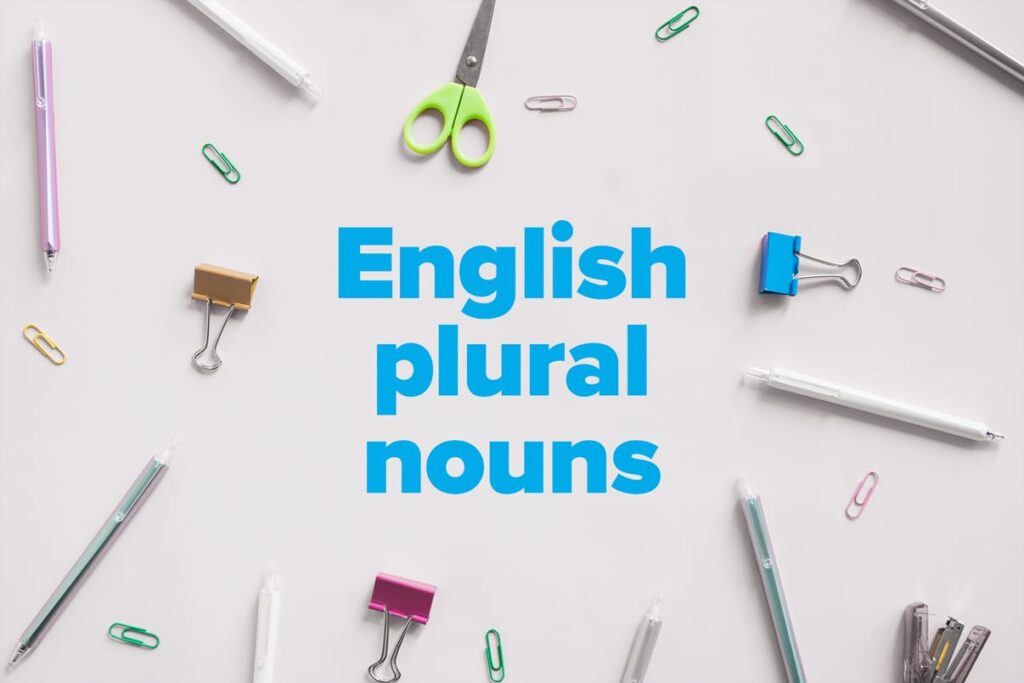Contents
- How Do Plurals Work in English?
- Regular Plural Nouns
- Add -s to most regular nouns
- Add -es to nouns ending in -o, -s, -x, -z, -sh or -ch
- Add -s to nouns that end with vowel + y
- Change the ending to -es for nouns ending in -is
- Change the ending to -ves for nouns ending in -f or -fe
- Change the ending to -ies for nouns ending in consonant + y
- Change the ending to -i for nouns ending in -us
- Change the ending to -a for certain nouns ending in -on
- Irregular Plural Nouns
- And One More Thing...
Plural Nouns in English: Simple Guide with Examples

English plural nouns can seem challenging for learners. But this guide makes it easier to turn any singular (one) noun into a plural (more than one) noun.
Discover the eight rules for making nouns plural in English below. I’ve also included common examples of nouns for each rule and the different kinds of irregular plural nouns.
Download: This blog post is available as a convenient and portable PDF that you can take anywhere. Click here to get a copy. (Download)
How Do Plurals Work in English?
The difference between the singular and plural forms of a noun is reflected in spelling. The most basic way to make an English noun plural is by adding -s, but as you’ll see below, there are a number of spelling rules to follow to make a noun plural and also many exceptions.
Regular Plural Nouns
The majority of English nouns are regular, which means they all follow the same format for their plural forms. Here are the rules for dealing with regular nouns:
Add -s to most regular nouns
For most regular English nouns, you simply add the letter -s to the noun.
It’s easy, but remember that another form looks very similar, and that’s the possessive form: “a dog’s bowl,” which means the bowl belongs to the dog. So watch out for that.
Here are a few common examples:
| Singular form | Plural form |
|---|---|
| dog | dogs |
| car | cars |
| apple | apples |
| mouth | mouths |
| photograph | photographs |
| photo | photos |
| taco | tacos |
| piano | pianos |
| boy | boys |
| roof | roofs |
| giraffe | giraffes |
| lemon | lemons |
| canyon | canyons |
| salon | salons |
Add -es to nouns ending in -o, -s, -x, -z, -sh or -ch
When the noun ends with -s, -x, -z, -sh or -ch, simply add -es after the noun.
| Singular form | Plural form |
|---|---|
| bus | buses |
| box | boxes |
| buzz | buzzes |
| wish | wishes |
| watch | watches |
| clash | clashes |
For most nouns ending with the letter -o, you have to add -es after the noun instead of -s.
| Singular form | Plural form |
|---|---|
| potato | potatoes |
| tomato | tomatoes |
| hero | heroes |
| cargo | cargoes |
Add -s to nouns that end with vowel + y
If a vowel comes before the letter -y, then it’s easy. You simply add -s after the noun.
| Singular form | Plural form |
|---|---|
| journey | journeys |
| day | days |
| way | ways |
| monkey | monkeys |
| toy | toys |
| guy | guys |
Change the ending to -es for nouns ending in -is
For nouns ending in -is , drop the -is and then add -es.
Let’s look at some common examples:
| Singular form | Plural form |
|---|---|
| axis | axes |
| oasis | oases |
| crisis | crises |
Change the ending to -ves for nouns ending in -f or -fe
For some nouns ending with -f or -fe, you change the F to V and then add -es.
Here are a few common examples:
| Singular form | Plural form |
|---|---|
| elf | elves |
| calf | calves |
| leaf | leaves |
| knife | knives |
| scarf | scarves |
| thief | thieves |
| wife | wives |
Change the ending to -ies for nouns ending in consonant + y
For nouns ending with a consonant + y, the general rule is to drop the -y and add -ies after the noun.
| Singular form | Plural form |
|---|---|
| fairy | fairies |
| candy | candies |
| sky | skies |
| library | libraries |
| memory | memories |
Change the ending to -i for nouns ending in -us
For nouns ending in -us, drop -us and add -i at the end of the word.
A few common examples are:
| Singular form | Plural form |
|---|---|
| cactus | cacti |
| fungus | fungi |
| stimulus | stimuli |
Change the ending to -a for certain nouns ending in -on
You probably won’t encounter this class of nouns very often, but it’s still important to know where you might need to use these words:
| Singular form | Plural form |
|---|---|
| criterion | criteria |
| phenomenon | phenomena |
Irregular Plural Nouns
If you’ve been an English learner for some time, you know there’ll always be special cases that don’t fit into any fixed formats or follow any rules. They are irregular, which means different.
Common Irregular Nouns to Memorize
They do things differently from everyone else and that’s what makes them so interesting. They don’t follow the standard rules and have to be memorized.
Let’s look at some examples:
| Singular form | Plural form |
|---|---|
| child | children (not "childs") |
| mouse | mice (not "mouses") |
| man | men (not "mans") |
| woman | women (not "womans") |
| ox | oxen (not "oxes") |
| die | dice (not "dies") |
Nouns with the same plural and singular forms
Talk about easy! There are some words that are exactly the same in their singular and plural forms.
Some common examples are below. You might notice that a lot of these words have to do with biology or animals.
| Singular form | Plural form |
|---|---|
| sheep | sheep |
| deer | deer |
| fish | fish |
| species | species |
| cattle | cattle |
| fruit | fruit |
Nouns that don’t change
Then there are some nouns that have no singular forms or no plural form. Because of this, you only have to learn the one form.
This is especially true with what’s called mass nouns. They have no distinct plural forms. Typically, they refer to nouns that often come in groups, or nouns that are somewhat abstract.
| Singular form | Plural form |
|---|---|
| - | pants |
| - | scissors |
| - | jeans |
| - | shorts |
| livestock | - |
| news | - |
| slang | - |
| bravery | - |
| love | - |
| money | - |
So now, I hope you have a clearer picture of how to make nouns plural in English.
Outside of this list, try to listen to how native speakers use these in their speech. If you don’t have natives around you, find a language exchange partner, or start watching English-language movies and TV shows.
Or you could try a virtual immersion program like FluentU.
FluentU takes authentic videos—like music videos, movie trailers, news and inspiring talks—and turns them into personalized language learning lessons.
You can try FluentU for free for 2 weeks. Check out the website or download the iOS app or Android app.
P.S. Click here to take advantage of our current sale! (Expires at the end of this month.)

As you watch English language content (especially with subtitles), you’ll get more familiar with how plurals work in English by hearing them in context.
It may take some time to become familiar with the rules but that’s okay. To learn them quicker, print out a copy of these rules and keep them handy for your reference. Pretty soon, you’ll be an expert at plural spellings. Good luck!
Download: This blog post is available as a convenient and portable PDF that you can take anywhere. Click here to get a copy. (Download)
And One More Thing...
If you like learning English through movies and online media, you should also check out FluentU. FluentU lets you learn English from popular talk shows, catchy music videos and funny commercials, as you can see here:
The FluentU app and website makes it really easy to watch English videos. There are captions that are interactive. That means you can tap on any word to see an image, definition, and useful examples.
For example, when you tap on the word "searching," you see this:
Learn all the vocabulary in any video with quizzes. Swipe left or right to see more examples for the word you’re learning.

FluentU helps you learn fast with useful questions and multiple examples. Learn more.
The best part? FluentU remembers the vocabulary that you’re learning. It gives you extra practice with difficult words—and reminds you when it’s time to review what you’ve learned. You have a truly personalized experience.
Start using the FluentU website on your computer or tablet or, better yet, download the FluentU app from the iTunes or Google Play store. Click here to take advantage of our current sale! (Expires at the end of this month.)










